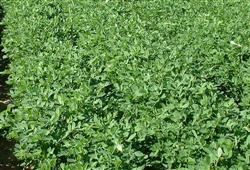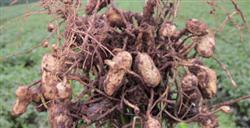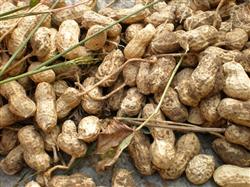What kind of micro-fertilizer can be applied to peanuts?

What micronutrients can be applied to peanuts? Trace elements play an irreplaceable role in the growth and development of peanuts, such as nitrogen, phosphorus, potassium, etc. Scientific application of trace element fertilizer is an important measure for high quality and high yield of peanuts. Iron fertilizer peanuts need to absorb 264 grams of iron for each ton of dry matter they form. Under iron deficiency, the plants were short, branches were few, flowering was late, flower quantity was few, nodules were few, root development was poor. Severe, vein chlorosis, yellowing, upper leaves were yellow-white, long leaves appear brown necrotic spots, until the leaves die. Applying iron fertilizer to iron-deficient soil can generally increase peanut yield by more than 10%. Application method: ① As base fertilizer, when preparing soil, apply 200~ 400g ferrous sulfate per mu (mixed with organic fertilizer or calcium superphosphate);② As seed fertilizer, soak seeds with 0.1% ferrous sulfate solution for 24 hours before sowing, take out and dry seed coat for sowing;③ Spraying outside roots, spraying 0.2% ferrous sulfate solution on leaves at flowering needle stage, pod setting stage or when new leaves appear yellowing symptoms, generally spraying once every 5~6 days, continuously spraying 2~3 times. For every ton of dry matter formed by boron fertilizer peanuts, 44 grams of boron need to be absorbed. When boron is deficient, the plant is short, branched and clustered, the color of the vein of the heart leaf is light, and the rest is dark and light green; the plant has few flowers or even no flowers, the root is easy to age, the ability to expand branches is weak, the fibrous root is few, the root tip has black spots, easy to necrosis, the kernel is bad; it is easy to form hollow fruits with shells and no kernels. Boron fertilizer could increase peanut yield by 7.8%~22.5% in boron-deficient soil. Application method: ① As base fertilizer, boric acid or borax 0.2~ 1 kg per mu (mixed with organic fertilizer or nitrogen and phosphorus fertilizer);(2) as seed fertilizer, soaking peanut seeds with boric acid or borax solution of 0.02%~0.05% for 4~6 hours before sowing, or mixing boric acid or borax with 0.4 kg per kg of peanut seeds;(3) as topdressing, mixing boric acid or borax 50~100 g per mu with a small amount of decomposed organic fertilizer and dressing before flowering;(4) Spraying outside the root, spraying 0.2% boric acid or borax solution on the leaves of peanut seedlings, initial flowering and full flowering. Manganese fertilizer Peanuts need to absorb 39 grams of manganese for each ton of dry matter formed. Under Mn deficiency, the interveinal part of leaves yellowed, while the veins tended to remain green. Manganese fertilizer could increase peanut yield by 8%~11% in manganese-deficient soil. Application method: ① As base fertilizer, apply manganese sulfate 1.5~3.0 kg per mu during soil preparation;② As seed fertilizer, soak seeds with 0.05~0.1% manganese sulfate solution for 12~24 hours before sowing;③ Spray outside roots, spray with 0.1% manganese sulfate solution every 10~14 days from 30~50 days after sowing to 15~20 days before harvest; If necessary, mix with fungicide for preventing and controlling peanut leaf spot. Zinc fertilizer Peanuts need to absorb 9 grams of zinc per ton of dry matter. When zinc deficiency occurs, the leaf strips chlorosis occurs. The strips are usually on the leaves closest to the petioles. When zinc deficiency occurs, the whole leaf chlorosis occurs. Applying zinc fertilizer to zinc-deficient soil could increase peanut yield by 12.5%~13.2%. Application method: ① As base fertilizer, apply 1 kg zinc sulfate per mu during soil preparation;② As seed fertilizer, soak seeds with 0.1~0.5% zinc sulfate solution for 12 hours before sowing, take out and dry seed coat for sowing. Molybdenum fertilizer peanuts need to absorb 1.32 grams of molybdenum per ton of dry matter. When molybdenum is deficient, crops usually show typical nitrogen deficiency symptoms; according to foreign studies, even in the case of complete molybdenum absence, peanuts can continue to blossom and bear fruit, but growth is inhibited. Applying molybdenum fertilizer to Mo deficient soil can increase peanut yield by 11.93%. Application method: ① As base fertilizer, 50~ 100g ammonium molybdate (mixed with calcium superphosphate) shall be applied per mu during soil preparation;② As seed fertilizer, soak seeds with 0.1~0.2% ammonium molybdate solution for 3~5 hours before sowing, or dress seeds with ammonium molybdate according to 0.2~0.3% of seed quantity;③ Spraying outside roots, spraying leaves with 0.1~0.2% ammonium molybdate solution during seedling stage and flowering stage of peanut. Click for more peanut planting technology Click for more grain and oil crop planting technology
- Prev

What are the hazards of peanut continuous cropping?
What are the hazards of peanut continuous cropping? Please introduce the harm of peanut continuous cropping as follows: 1. It causes serious soil deficiency. Because the root of peanut has a large number of rhizobium, it is not very sensitive to nitrogen. Due to continuous cropping, the soil is lack of elements and can not meet the nutrients needed by peanuts, thus affecting the normal growth and development of peanuts. Continuous cropping time.
- Next

How to be sure that peanuts can be harvested?
How to be sure that peanuts can be harvested? Please introduce that the harvest time of peanuts should be determined according to the appearance of the plant and the maturity of the pod. From the appearance of the plant, the upper leaves turned yellow, the middle and lower leaves changed from green to yellow and gradually fell off, the stem turned yellowish green and withered and soft, the satiety rate was more than 75%, the pod shell hardened, and most pods.
Related
- The first cup of black tea in spring, the flavor and history of tea gardens in Kenya, Africa
- The computer can not only choose potatoes, but also grow tea rice. AI will grow winter oolong tea champion.
- It is not only the inflated tea bitten by insects, but also engraved with the four seasons tea in Beipu.
- The Oriental Beauty Tea Festival in Zhuxian County takes the stage at the weekend to experience the plus-size feast of oil tea.
- & quot; Oriental Beauty Tea & Exploration of Emei in Hsinchu, the hometown of quot;
- The new variety of strawberry "Tainong 1" dessert is the first choice with mellow aroma. Crimson gorgeous
- History of Tea in Taiwan: from Wild Inner Mountain to Export Tea Garden
- Two types of Taiwan Oriental Beauty Black Tea won the British three-Star Award for Childhood Tea Xiang Zhang Jiaqi changed from pilot to champion tea maker.
- Banana species and varieties: the planting history of Taiwan Xianren banana and dwarf banana is long, is banana disease resistant?
- Coffee planting Technology: Qianjie Coffee from Seedling to harvesting

